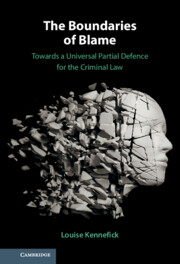Book contents
- The Boundaries of Blame
- The Boundaries of Blame
- Copyright page
- Contents
- Acknowledgements
- Introduction
- Part I Purpose
- Part II Paradigm and Principle
- Part III Partial Excuse (Practice, Doctrine, and Theory)
- 5 Universality
- 6 Diminished Responsibility
- 7 Bounded Causal Theory
- Part IV Proposal
- Conclusion
- Bibliography
- Index
5 - Universality
Understanding and Expanding the Bounds of Partial Excuse
from Part III - Partial Excuse (Practice, Doctrine, and Theory)
Published online by Cambridge University Press: 26 July 2025
- The Boundaries of Blame
- The Boundaries of Blame
- Copyright page
- Contents
- Acknowledgements
- Introduction
- Part I Purpose
- Part II Paradigm and Principle
- Part III Partial Excuse (Practice, Doctrine, and Theory)
- 5 Universality
- 6 Diminished Responsibility
- 7 Bounded Causal Theory
- Part IV Proposal
- Conclusion
- Bibliography
- Index
Summary
Chapter 5 marks the beginning of a more pointed analysis and justification of partial excuse across Part III, as the target site of the Real Person Approach. The chapter is concerned with exploring the nature and purpose of partial excuse through a historical overview, and with clarifying the version of the defence used to underpin the Universal Partial Defence (UPD), through touring divergent definitional and structural approaches of other common law jurisdictions. Key issues that bear on the definition of the UPD are also introduced. This analysis forms the backdrop of the argument for universalising partial excuse across all offence categories and expanding its grounds beyond mental disorder and provocation/loss of control. Core challenges to universalisation are explained and responded to, concerning the application of partial excuse to homicide only, its characterisation as a form of mitigation at the pre-verdict stage, and issues relating to both coordination and the notion of partial responsibility.
Keywords
Information
- Type
- Chapter
- Information
- The Boundaries of BlameTowards a Universal Partial Defence for the Criminal Law, pp. 145 - 180Publisher: Cambridge University PressPrint publication year: 2025
Accessibility standard: Inaccessible, or known limited accessibility
Why this information is here
This section outlines the accessibility features of this content - including support for screen readers, full keyboard navigation and high-contrast display options. This may not be relevant for you.Accessibility Information
Content Navigation
Allows you to navigate directly to chapters, sections, or non‐text items through a linked table of contents, reducing the need for extensive scrolling.
Provides an interactive index, letting you go straight to where a term or subject appears in the text without manual searching.
Reading Order & Textual Equivalents
You will encounter all content (including footnotes, captions, etc.) in a clear, sequential flow, making it easier to follow with assistive tools like screen readers.
Visual Accessibility
You will still understand key ideas or prompts without relying solely on colour, which is especially helpful if you have colour vision deficiencies.
You benefit from high‐contrast text, which improves legibility if you have low vision or if you are reading in less‐than‐ideal lighting conditions.
